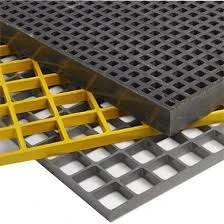loading...
- No. 9, Xingyuan South Street, Dongwaihuan Road, Zaoqiang County, Hengshui, Hebei, China
- admin@zjcomposites.com
- +86 15097380338
- Welcome to visit our website!
Innovative FRP Louver Solutions for Enhanced Airflow and Aesthetic Appeal
The Importance of FRP Louvers in Modern Architecture
In the realm of modern architecture, functional and aesthetic components are vital in the design and construction of buildings. Among these components, FRP (Fiberglass Reinforced Plastic) louvers have emerged as a significant feature that offers a mix of utility, durability, and design flexibility. This article will explore the benefits of FRP louvers, their applications, and why they are increasingly favored in contemporary construction.
What are FRP Louvers?
FRP louvers are systems made from fiberglass-reinforced plastic, a composite material known for its strength, lightweight properties, and resistance to environmental factors. These louvers are designed to allow airflow while minimizing the entry of rain, snow, and debris. They can also serve aesthetic purposes, enhancing the visual appeal of buildings by providing clean lines and modern designs.
Benefits of FRP Louvers
1. Durability and Longevity One of the primary advantages of FRP louvers is their exceptional durability. The fiberglass material is resistant to corrosion, rust, and harsh weather conditions, making it suitable for a wide range of environments. Unlike traditional materials such as wood or metal, FRP does not rot or require frequent maintenance, ensuring a longer lifespan.
2. Lightweight FRP louvers are considerably lighter than their metal counterparts. This characteristic simplifies the installation process, reducing both labor time and costs. Lightweight materials also lessen the load on the building’s structural framework, which can be an essential consideration in designing high-rise buildings or large structures.
3. Versatility in Design Architects and interior designers appreciate the versatility of FRP louvers. They can be customized in various shapes, sizes, and colors, allowing for creative applications in diverse architectural styles. Whether used in commercial, residential, or industrial buildings, FRP louvers can complement a wide range of aesthetics.
frp louver

4. Energy Efficiency Properly designed louvers can enhance a building's energy efficiency by improving natural ventilation. This can reduce the reliance on artificial heating and cooling systems, thereby lowering energy consumption and costs. Additionally, strategically placing louvers can mitigate heat gain by controlling the amount of sunlight that enters a building.
5. Environmental Friendly With an increased focus on sustainability, using materials like FRP, which can be manufactured with low energy consumption, aligns with green building practices. Many modern FRP products also have recyclable components, contributing to a decreasing carbon footprint.
Applications of FRP Louvers
FRP louvers are used in various applications across multiple industries. In commercial buildings, they can be installed in HVAC systems to optimize airflow while providing aesthetic value. Industrial facilities utilize FRP louvers for exhaust and ventilation purposes, where durability is paramount. Moreover, in architectural façade designs, louvers serve as crucial features that can define the building's character while ensuring functional performance.
Conclusion
As the construction industry continues to advance, materials that marry functionality and aesthetics are increasingly sought after. FRP louvers exemplify this trend, providing a solution that meets modern architectural demands. Their combination of durability, lightweight properties, design versatility, energy efficiency, and environmental friendliness makes them an ideal choice for various building applications. As architects and builders strive to create innovative structures that stand the test of time, the role of FRP louvers will undoubtedly grow, solidifying their place in the future of modern architecture.
In summary, FRP louvers not only enhance the performance and design of buildings but also contribute to a sustainable approach to construction, making them a fundamental component in contemporary architectural projects.
-
The Rise of FRP Profiles: Strong, Lightweight, and Built to LastNewsJul.14,2025
-
SMC Panel Tanks: A Modern Water Storage Solution for All EnvironmentsNewsJul.14,2025
-
GRP Grating: A Modern Solution for Safe and Durable Access SystemsNewsJul.14,2025
-
Galvanized Steel Water Tanks: Durable, Reliable, and Ready for UseNewsJul.14,2025
-
FRP Mini Mesh Grating: The Safer, Smarter Flooring SolutionNewsJul.14,2025
-
Exploring FRP Vessels: Durable Solutions for Modern Fluid HandlingNewsJul.14,2025
-
GRP Structures: The Future of Lightweight, High-Performance EngineeringNewsJun.20,2025
